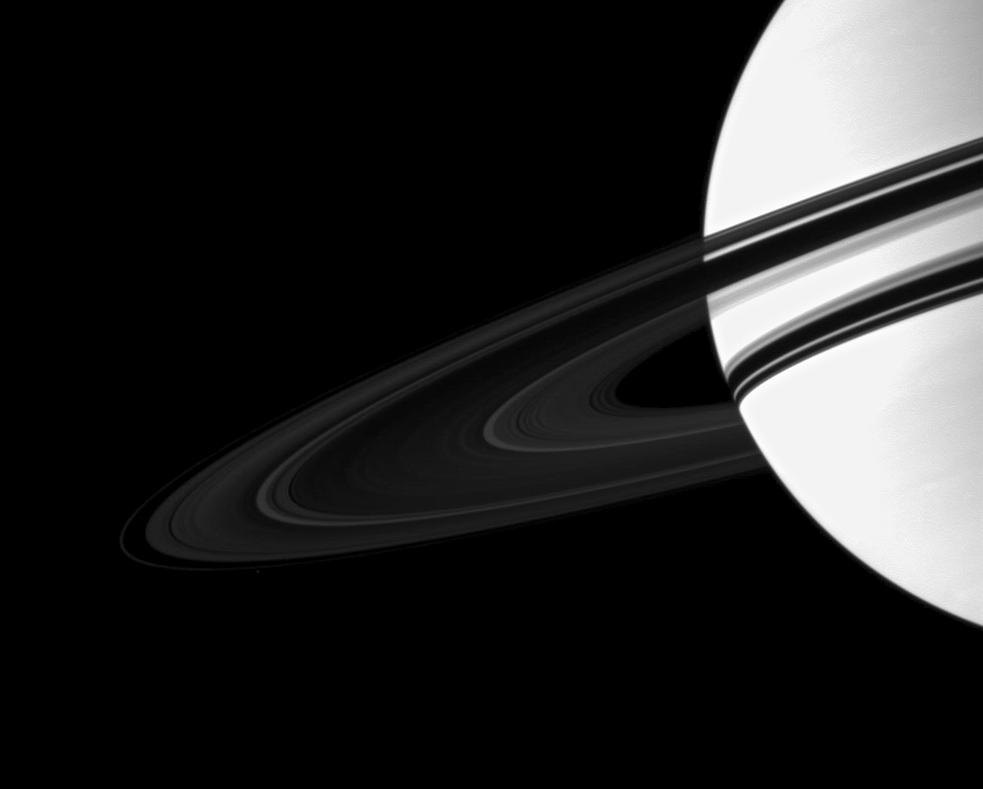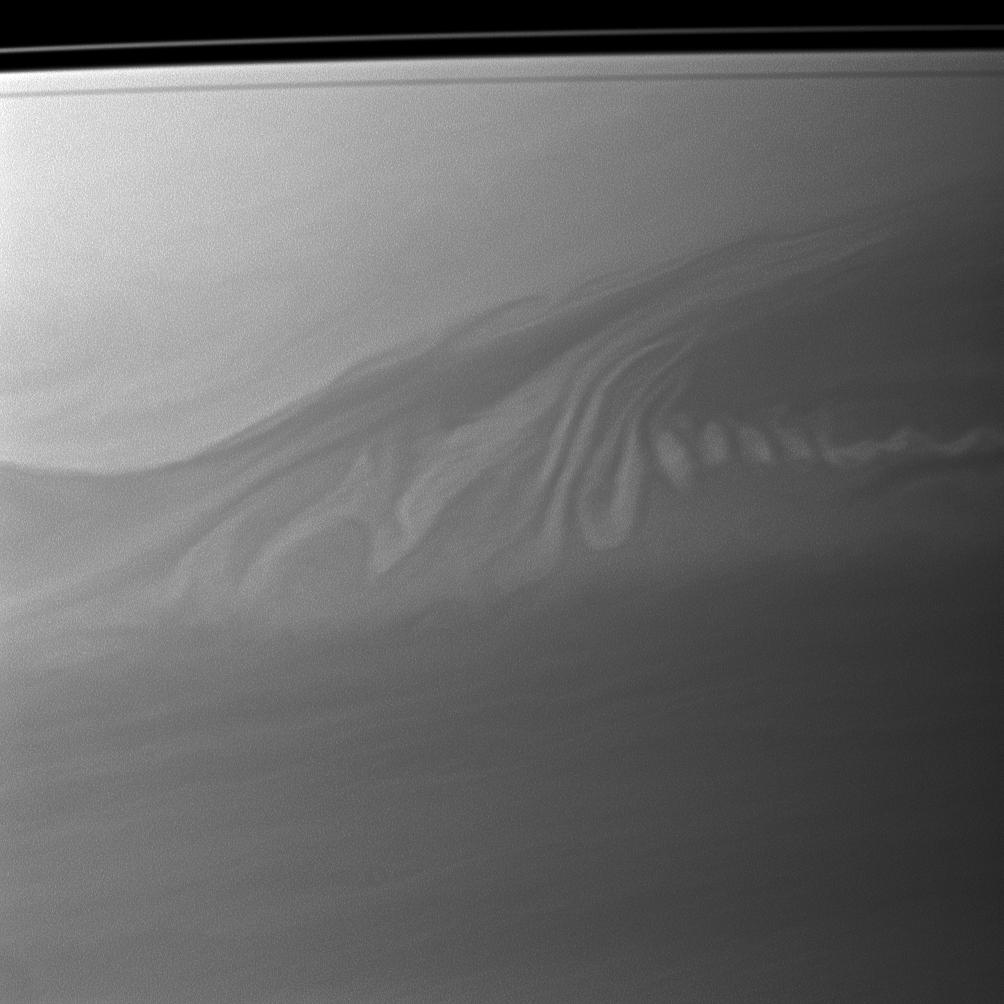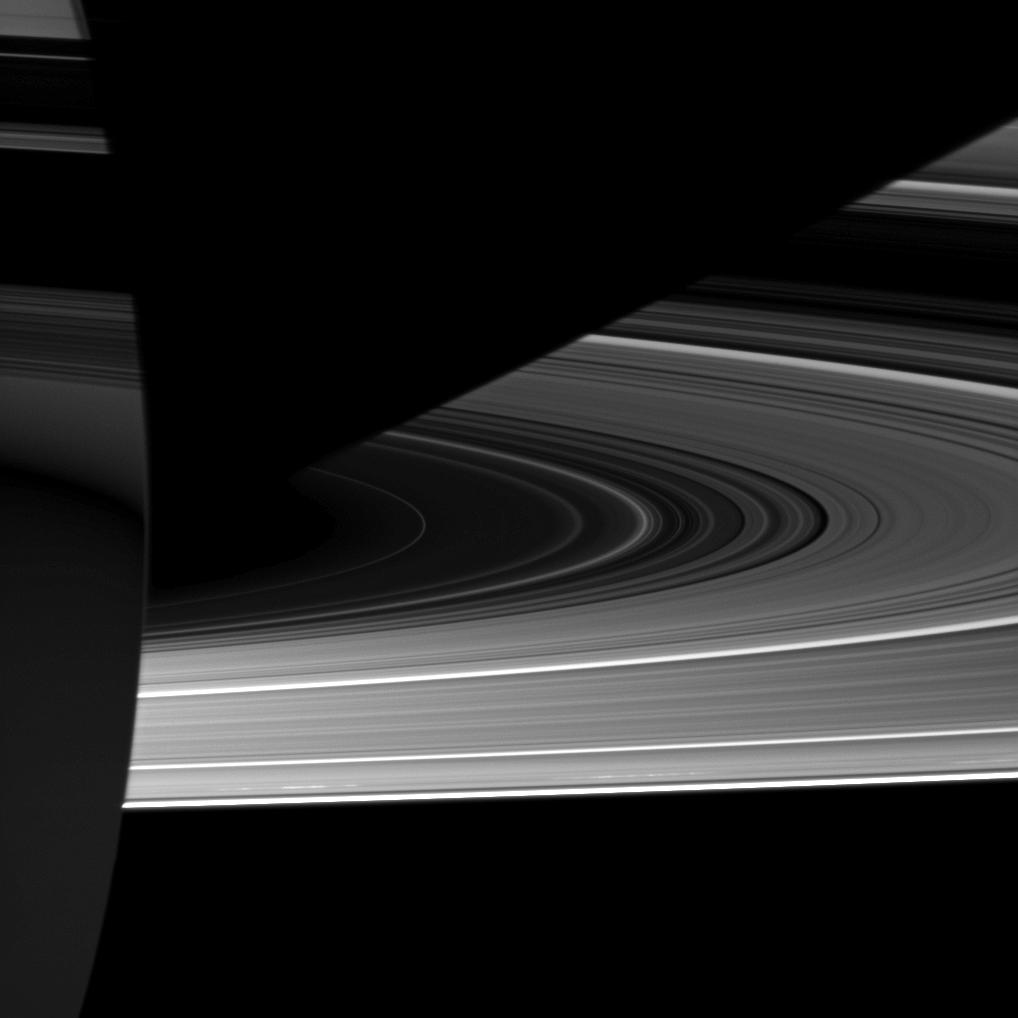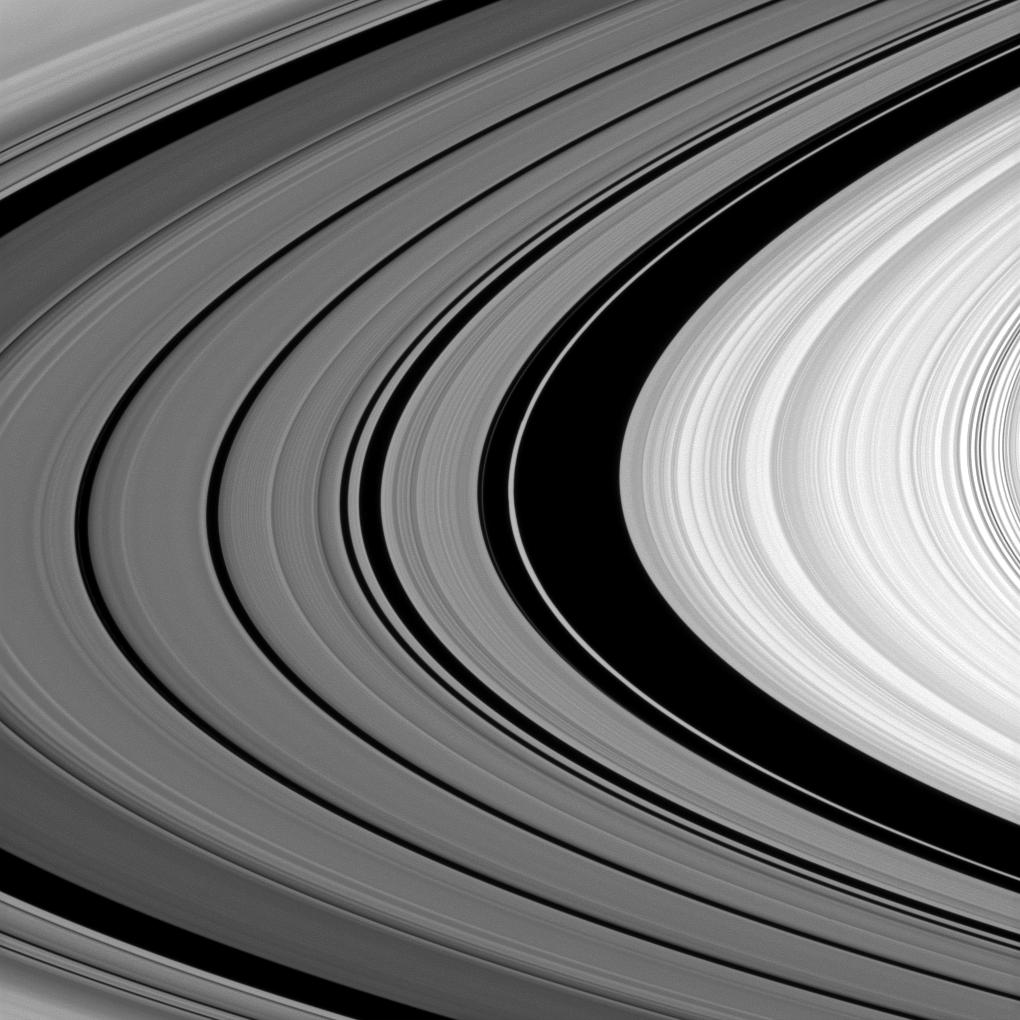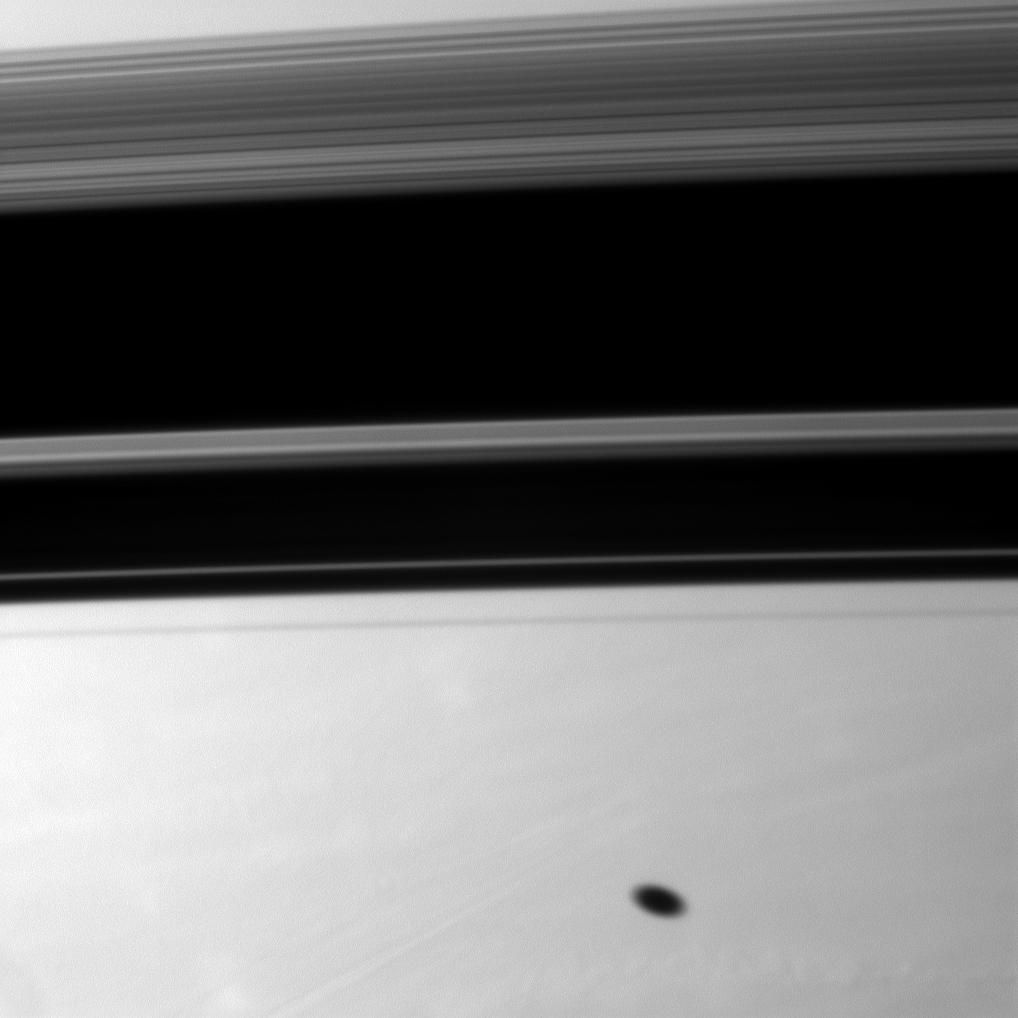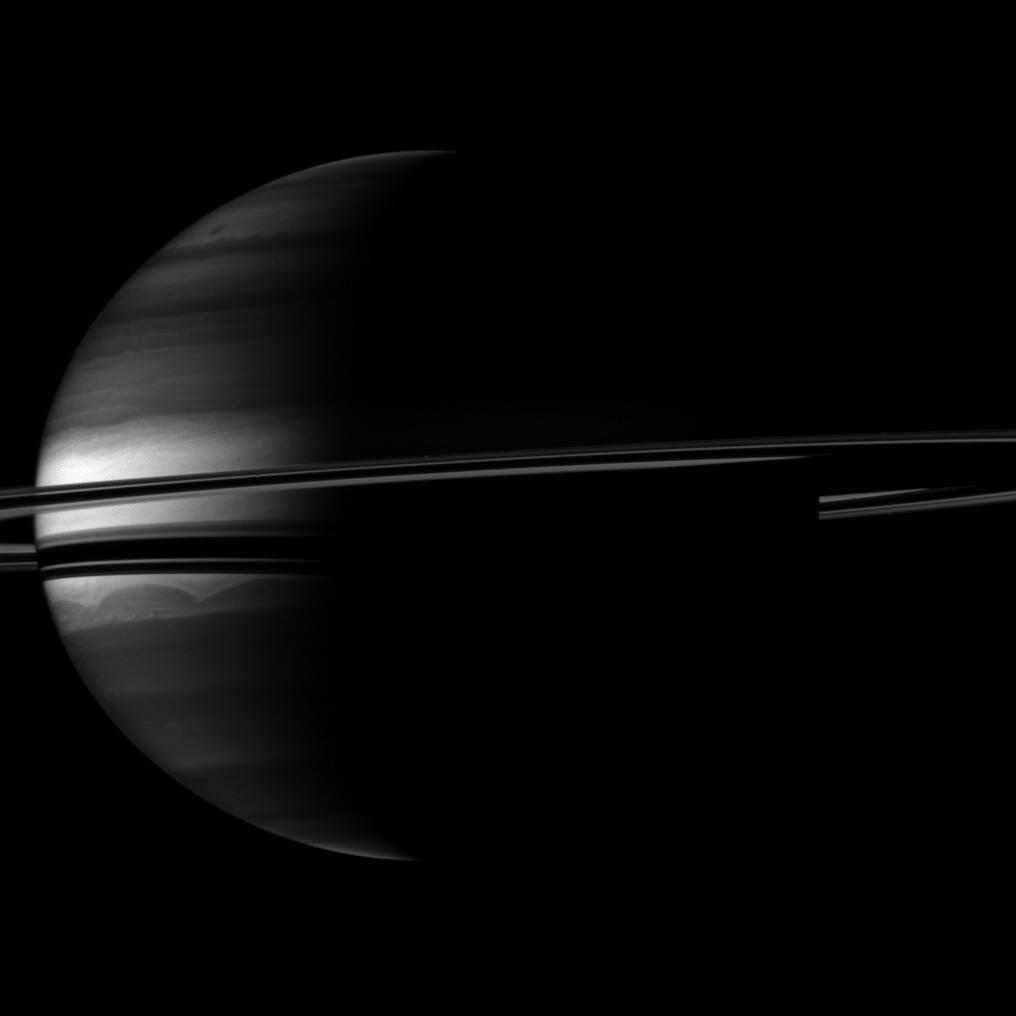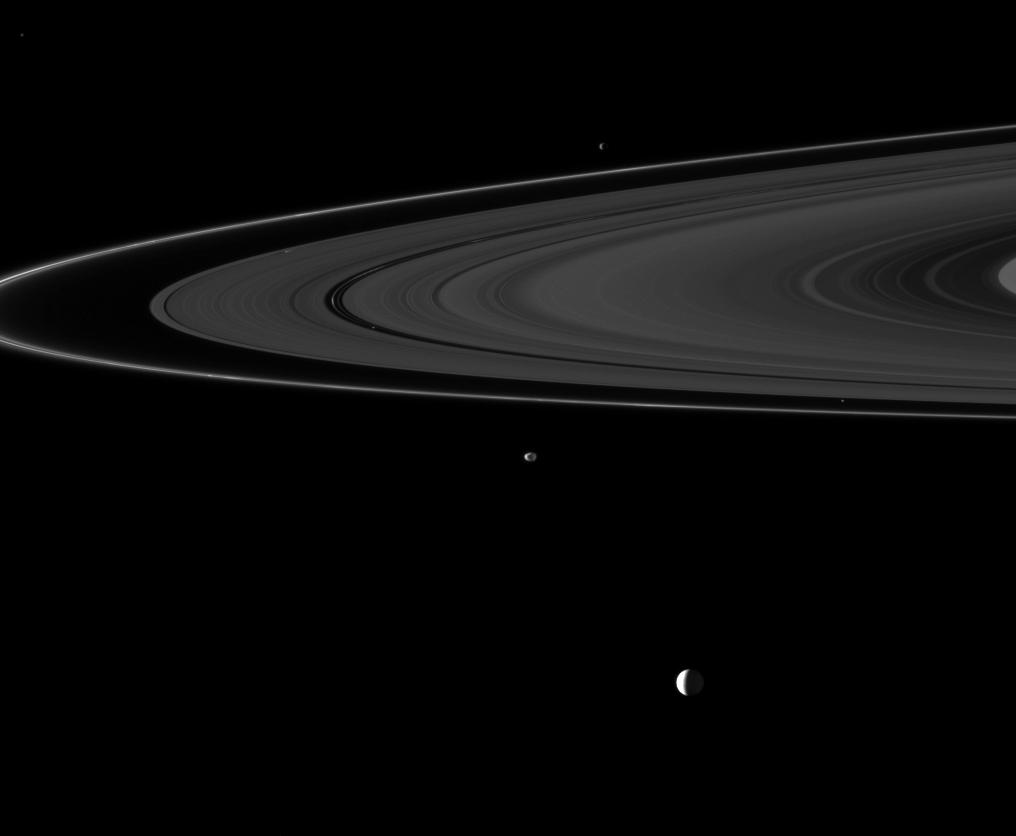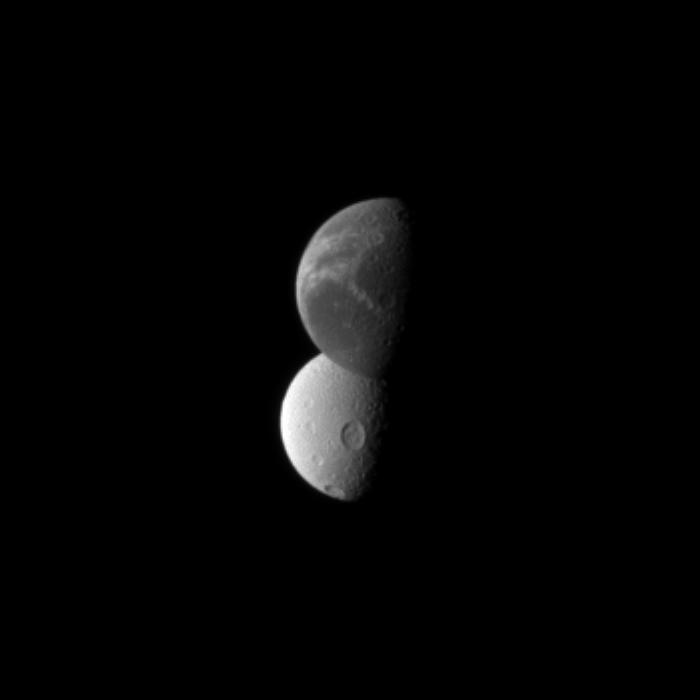Page 2 of 3
Re: Saturn's Neighborhood
Posted: Sun Aug 01, 2010 3:15 pm
by owlice
Wider Shadow
http://photojournal.jpl.nasa.gov/catalog/PIA12685
Credit: NASA/JPL/Space Science Institute
The shadow of Saturn's rings grows wider on the planet as the planet moves away from its August 2009 equinox, when the rings cast a pencil-thin shadow.
Saturn is overexposed here in order to show the dim rings. Pandora (below the rings to the left) has been brightened by a factor of 1.3 relative to the planet and the rings to enhance its visibility. The image was taken using a compression scheme that decreases image file size for storage onboard the spacecraft, and thus the image appears slightly blocky, or "pixelated" following enhancement.
This view looks toward the southern, unilluminated side of the rings from about 7 degrees below the ringplane.
The image was taken in visible light with the Cassini spacecraft wide-angle camera on June 24, 2010. The view was acquired at a distance of approximately 2.1 million kilometers (1.3 million miles) from Saturn and at a sun-Saturn-spacecraft, or phase, angle of 84 degrees. Image scale is 124 kilometers (77 miles) per pixel.
Re: Saturn's Neighborhood
Posted: Sun Aug 01, 2010 6:15 pm
by owlice
Chunks of Ice
http://photojournal.jpl.nasa.gov/catalog/PIA12683
NASA/JPL/Space Science Institute
A pair of Saturn's small, icy satellites accompany the planet's rings in this Cassini spacecraft snapshot.
Janus (179 kilometers, or 111 miles across) is farthest from Cassini here and occupies the top of the image. Prometheus (86 kilometers, or 53 miles across) orbits between the main rings and the thin F ring. The rings are between Janus and Prometheus. This view looks toward the northern, sunlit side of the rings from just above the ringplane.
The image was taken in visible green light with the Cassini spacecraft narrow-angle camera on April 9, 2010. The view was acquired at a distance of approximately 1 million kilometers (621,000 miles) from Prometheus and at a Sun-Prometheus-spacecraft, or phase, angle of 65 degrees. The view was acquired at a distance of approximately 1.1 million kilometers (684,000 miles) from Janus and at a sun-Janus-spacecraft, or phase, angle of 65 degrees. Image scale is about 6 kilometers (4 miles) per pixel on Prometheus and about 7 kilometers (4 miles) per pixel on Janus.
Saturn's Neighborhood: Pan
Posted: Wed Aug 04, 2010 3:31 pm
by bystander
Pan in Action
NASA JPL | Cassini Equinox Mission | 04 Aug 2010
PIA12691: Pan in Action
Saturn's small, ring-embedded moon Pan, on the extreme right of this Cassini spacecraft image, can be seen interacting with the ringlets that share the Encke Gap of the A ring with this moon.
Pan is 28 kilometers, or 17 miles, across. This view looks toward the northern, sunlit side of the rings from about 11 degrees above the ringplane.
The image was taken in visible light with the Cassini spacecraft narrow-angle camera on June 2, 2010. The view was acquired at a distance of approximately 875,000 kilometers (544,000 miles) from Saturn and at a sun-Saturn-spacecraft, or phase, angle of 130 degrees. Image scale is 5 kilometers (3 miles) per pixel.
Credit: NASA/JPL/SSI
Saturn's Neighborhood: Enceladus
Posted: Fri Aug 06, 2010 3:09 pm
by bystander
Enceladus: Orbiting in Its Ice
NASA JPL | Cassini Equinox Mission | 06 Aug 2010
Orbiting in Its Ice
As Enceladus spews water ice from its south polar region, the Cassini spacecraft chronicles the moon creating Saturn's faint E ring, in which the moon orbits.
See
Bursting at the Seams and
Ghostly Fingers of Enceladus to learn more about this active moon and how it creates the E ring. The E ring can just barely be seen here. The most brightly lit terrain seen on the moon here (on the left of the moon) is illuminated by the sun and is on the leading hemisphere of Enceladus (504 kilometers, or 313 miles across). Light reflected off Saturn covers a larger area on the Saturn-facing side of the moon on the right.
North on Enceladus is up. This view looks toward the northern, sunlit side of the rings from just above the ringplane.
The image was taken in visible light with the Cassini spacecraft narrow-angle camera on April 26, 2010. The view was obtained at a distance of approximately 993,000 kilometers (617,000 miles) from Enceladus and at a sun-Enceladus-spacecraft, or phase, angle of 162 degrees. Image scale is 6 kilometers (4 miles) per pixel.
Credit: NASA/JPL/SSI
Re: Saturn's Neighborhood
Posted: Mon Aug 09, 2010 5:42 pm
by bystander
Correction:
Enceladus and G Ring
As Enceladus spews water ice from its south polar region, Cassini also shows Saturn's faint G ring before the moon.
See Bursting at the Seams and Ghostly Fingers of Enceladus to learn more about this active moon and how it creates Saturn's E ring. The E ring is too diffuse to be seen here, but the G ring can just barely be seen in this image. The G ring is actually closer to Cassini here even though the ring appears to be behind Enceladus. ...
Saturn's Neighborhood: Iapetus
Posted: Thu Aug 12, 2010 12:56 pm
by bystander
Iapetus: Fat Comma
CICLOPS | 12 Aug 2010
Iapetus: Fat Comma
With its light and dark surface Iapetus appears almost like a comma punctuation mark or a yin and yang symbol in this Cassini image.
See the
Global View of Iapetus' Dichotomy to learn more about the brightness dichotomy on Iapetus. This view looks toward the Saturn-facing side of Iapetus (1471 kilometers, 914 miles across). North on is up and rotated 41 degrees to the right.
The image was taken in visible light with the Cassini spacecraft narrow-angle camera on May 12, 2010. The view was acquired at a distance of approximately 1.5 million kilometers (932,000 miles) from Iapetus and at a Sun-Iapetus-spacecraft, or phase, angle of 74 degrees. Image scale is 9 kilometers (6 miles) per pixel.
Credit: NASA/JPL/SSI
Saturn's Neighborhood: Enceladus, Tethys and Dione
Posted: Sun Aug 15, 2010 4:05 am
by bystander
Event: Special Image Release: Rev 136 Raw Preview
Credit: NASA/JPL/Space Science Institute/Josh Riley | 14 Aug 2010
Saturn's Neighborhood: Clouds
Posted: Wed Sep 15, 2010 6:19 pm
by bystander
Coffee and Cream Clouds
NASA JPL | Cassini Equinox Mission | 15 Sept 2010
Coffee and Cream Clouds
Clouds in Saturn's atmosphere create an intricate pattern reminiscent of whipped cream swirling in coffee.
The view is centered on a region 15 degrees south of the planet's equator. The image was taken with the Cassini spacecraft narrow-angle camera on July 18, 2010 using a spectral filter sensitive to wavelengths of near-infrared light centered at 727 nanometers.
The view was obtained at a distance of approximately 2.4 million kilometers (1.5 million miles) from Saturn and at a sun-Saturn-spacecraft, or phase, angle of 107 degrees. Image scale is 14 kilometers (9 miles) per pixel.
Credit: NASA/JPL/SSI
Re: Saturn's Neighborhood
Posted: Wed Sep 15, 2010 6:27 pm
by owlice
Oh, that's very cool!!! Thank you!
Re: Saturn's Neighborhood
Posted: Thu Sep 16, 2010 12:34 am
by rstevenson
Looks like a freshly poured stout to me. Hmmmm, I'm getting thirsty.
Rob
Saturn's Neighborhood: Rings
Posted: Mon Oct 04, 2010 7:17 pm
by bystander
Light and Dark Tricks
NASA JPL Cassini Solstice Mission | 04 Oct 2010
Capturing the interplay between light and shadow, the Cassini spacecraft looks toward the night side of Saturn where sunlight reflected off the rings has dimly illuminated what would otherwise be the dark side of the planet.
Saturn's southern hemisphere occupies the lower left of the image, and Cassini is looking up toward the rings here. The planet casts a shadow that cuts across the rings in the top right of the image. In the top left of the image, it seems that the rings are casting shadows on the planet. That is not the case. The dark areas in the top left are the rings themselves, and they are blocking Cassini's view of the light that is reflected off the rings and onto the planet, as seen in the middle left and lower left of the image.
For a different perspective,
see this view from the
Solar System Simulator.
Some sunlight from the day side of the planet scatters through the planet's atmosphere and illuminates the limb of Saturn in the middle left of the image. See
Activity Past Dark Side and
High-Phase Drama for similar views and to learn more.
This view looks toward the southern, unilluminated side of the rings from about 4 degrees below the ringplane.
The image was taken in visible light with the Cassini spacecraft wide-angle camera on Sept. 2, 2010. The view was obtained at a distance of approximately 435,000 kilometers (270,000 miles) from Saturn and at a Sun-Saturn-spacecraft, or phase, angle of 178 degrees. Image scale is 22 kilometers (14 miles) per pixel.
Credit: NASA/JPL/SSI
Re: Saturn's Neighborhood
Posted: Mon Oct 04, 2010 7:39 pm
by owlice
I think I don't understand this image, its perspective. If Cassini is looking toward the dark side, the sun is on the other side, yes? What is the black shadow? If looking toward the sun (because we're looking at the dark side of Saturn), what is casting that shadow? (This assumes it's a shadow.)
The view from the Solar System Simulator didn't help.

The links in the next paragraph didn't help me understand this image, either, but wow, are they fabulous images!!
Re: Saturn's Neighborhood
Posted: Mon Oct 04, 2010 8:00 pm
by bystander
The Sun is to the image left and behind Saturn. The rings on the right are on the day (far) side of Saturn, extending away from us, top to bottom. The rings in the upper left are between Cassini and Saturn and are caught in silhouette. Cassini is on the night side of Saturn looking up and towards the terminator. That's the way I interpret it.
Saturn's Neighborhood: Cassini Division
Posted: Mon Oct 11, 2010 5:28 pm
by bystander
Detailing the Division
NASA JPL | Cassini Solstice Mission | 11 Oct 2010
The Cassini spacecraft looks between Saturn's A and B rings to spy structure in the Cassini Division.
The Cassini Division, occupying the middle and left of the image, contains five dim bands of ring material, but not all of the division is shown in this image. The B ring is on the right of the image. The Huygens Gap is the widest black swath near the middle of the image. See A Full Sweep of Saturn's Rings, The Familiar Division and New Rings for Cassini's Division to learn more. This view looks toward the northern, sunlit side of the rings from about 3 degrees above the ringplane.
The image was taken in visible light with the Cassini spacecraft narrow-angle camera on Sept. 3, 2010. The view was obtained at a distance of approximately 443,000 kilometers (275,000 miles) from Saturn. Image scale is 2 kilometers (1 mile) per pixel.
Saturn's Neighborhood: Nine Moons, 62 Hours
Posted: Wed Oct 20, 2010 3:33 pm
by bystander
The (Long) Weekend Warrior: Nine Moons, 62 Hours
NASA JPL-Caltech Cassini | 19 Oct 2010
Taking a long-weekend road trip, NASA's Cassini spacecraft successfully glided near nine Saturnian moons, sending back a stream of raw images as mementos of its adrenaline-fueled expedition. The spacecraft sent back particularly intriguing images of the moons Dione and Rhea.
The Dione and Rhea pictures are the highest-resolution views yet of parts of their surfaces. The views of the southern part of Dione's leading hemisphere (the part of the moon that faces forward in its orbit around Saturn) and the equatorial region of Rhea's leading hemisphere are more detailed than the last time we saw these terrains with NASA's Voyager spacecraft in the early 1980s.
...
Images of the moon Mimas, captured just before it went into shadow behind Saturn, will be compared to thermal maps made earlier this year that showed an unexpected
"Pac-Man" heat pattern ...
Cassini also caught a picture of the tiny, 4-kilometer-wide (3-mile-wide) moon Pallene, in front of the planet Saturn, which is more than 120,000 kilometers (75,000 miles) wide at its equator.
Cassini's elliptical orbital pattern around Saturn means it can target moons for flybys about once or twice a month. The flybys on this particular Cassini road trip were "non-targeted" flybys, meaning navigators did not refine Cassini's path to fly over particular points on each moon.
Cassini's long weekend started on Thursday, Oct. 14, at 5:07 p.m. UTC (9:07 a.m. PDT), when it passed by Saturn's largest moon Titan at an altitude of 172,368 kilometers (107,104 miles) above the surface. Then came a whirlwind 21 hours in which Cassini flew by Polydeuces at 116,526 kilometers (72,406 miles), Mimas at 69,950 kilometers (43,465 miles), Pallene at 36,118 kilometers (22,443 miles), Telesto at 48,455 kilometers (30,109 miles), Methone at 105,868 kilometers (65,783 miles), Aegaeon at 96,754 kilometers (60,120 miles) and Dione at 31,710 kilometers (19,704 miles). Cassini's last visit -- Rhea at 38,752 kilometers (24,079 miles) – took place at 6:47 a.m. UTC on Oct. 17 (10:47 p.m. PDT on Oct. 16).
Scientists decided in advance which observations they wanted to make while the spacecraft was cruising past all the moons. They chose to obtain images of Titan, Mimas, Pallene, Dione and Rhea. They also obtained thermal scans of Mimas, Dione and Rhea.
Credit: NASA/JPL/SSI
Titan, Pallene, Dione and Rhea Rev 139 Raw Preview
CICLOPS | 18 Oct 2010
Titan Rev 139 Raw Preview
CICLOPS | 20 Oct 2010
Re: Saturn's Neighborhood
Posted: Wed Oct 20, 2010 4:00 pm
by owlice
Thank you, bystander! I love these images.
Saturn's Neighborhood: Shadows
Posted: Mon Oct 25, 2010 3:30 pm
by bystander
Shadows on Saturn
NASA JPL Cassini Solstice Mission | 25 Oct 2010
Shadows on Saturn
Saturn's moon Mimas casts a elliptical shadow on the planet south of the larger, wider shadows cast by the planet's rings.
Mimas and the rings are not shown here. This view looks toward the southern hemisphere of the planet.
The image was taken with the Cassini spacecraft narrow-angle camera on Sept. 8, 2010 using a spectral filter sensitive to wavelengths of near-infrared light centered at 750 nanometers. The view was obtained at a distance of approximately 2.2 million kilometers (1.4 million miles) from Saturn and at a Sun-Saturn-spacecraft, or phase, angle of 82 degrees. Image scale is 13 kilometers (8 miles) per pixel.
Credit: NASA/JPL/SSI
Saturn's Neighborhood: Rings
Posted: Mon Nov 01, 2010 2:15 pm
by bystander
Rings Around a Crescent
NASA JPL Cassini Solstice Mission | 01 Nov 2010
Rings Around a Crescent
A crescent Saturn appears nestled within encircling rings in this Cassini spacecraft image.
Clouds swirl through the atmosphere of the planet. Prometheus (86 kilometers, or 53 miles across) orbits between the main rings and the thin F ring, and this moon appears as a speck above the rings near the middle of the image.
This view looks toward the southern, unilluminated side of the rings from about 3 degrees below the ringplane.
The image was taken with the Cassini spacecraft wide-angle camera on Sept. 14, 2010 using a spectral filter sensitive to wavelengths of near-infrared light centered at 890 nanometers. The view was obtained at a distance of approximately 2.6 million kilometers (1.6 million miles) from Saturn and at a Sun-Saturn-spacecraft, or phase, angle of 100 degrees. Image scale on Saturn is 151 kilometers (94 miles) per pixel.
Credit: NASA/JPL/SSI
Saturn's Neighborhood: Sextet of Moons
Posted: Mon Nov 22, 2010 3:54 pm
by bystander
Cassini Solstice Mission | 22 Nov 2010
Sextet of Moons
Six of Saturn's moons orbiting within and beyond the planet's rings are collected in this Cassini spacecraft imageSix of Saturn's moons orbiting within and beyond the planet's rings are collected in this Cassini spacecraft image.
Enceladus (504 kilometers, or 313 miles across) is the largest moon in this image and appears at the bottom. Janus (179 kilometers, or 111 miles across) orbits beyond the rings near the center of the image. Epimetheus (113 kilometers, or 70 miles across) orbits beyond the rings near the top of the image. Atlas (30 kilometers, or 19 miles across) appears as a tiny speck between the main rings and the thin F ring on the right. Daphnis (8 kilometers, or 5 miles across), which orbits in the narrow Keeler Gap of the A ring, appears as a small, bright speck on the left of the image. Pan (28 kilometers, or 17 miles across), which orbits in the Encke Gap of the A ring, also appears as a bright speck on the left of the image. Daphnis is farther to the left of the image than Pan.
Although Enceladus appears to be in the foreground here, that moon, at a distance of 3.1 million kilometers (1.9 million miles), is actually farthest away from Cassini in this image. Janus is 3 million kilometers (1.9 million miles) from the spacecraft. The view was obtained at a distance of approximately 2.8 million kilometers (1.7 million miles) from Epimetheus.
The rings lie between Janus and Epimetheus. This view looks toward the southern, unilluminated side of the rings from about 2 degrees below the ringplane.
Enceladus is a very reflective body. To enhance visibility, the other moons and the rings have been brightened by a factor of 3.4 relative to Enceladus.
The image was taken in visible light with the Cassini spacecraft narrow-angle camera on Oct. 6, 2010. Image scale is approximately 19 kilometers (12 miles) per pixel on Enceladus, about 18 kilometers (11 miles) per pixel on Janus and about 17 kilometers (11 miles) per pixel on Epimetheus.
Credit: NASA/JPL/SSI
Saturn's Neighborhood: Dione & Enceladus
Posted: Tue Jan 18, 2011 7:51 pm
by bystander
Cassini Solstice Mission | 2011 Jan 17
Dione's Deception
On the top right of this Cassini spacecraft image, Saturn's moon Dione may appear closer to the spacecraft because it is larger than the moon Enceladus in the lower left. However, Enceladus was actually closer to the spacecraft when this image was captured.
Dione (1,123 kilometers, or 698 miles, across) is actually more than twice the size of Enceladus (504 kilometers, or 313 miles, across). Dione's bright ''wispy'' terrain can be seen here. See
Dione's Icy Wisps and
Highest Resolution View of Dione to learn more about this terrain. This view looks toward the area between the trailing hemisphere and Saturn-facing side of Dione.
The highly reflective surface of Enceladus also stands out here. This view looks toward the trailing hemisphere of Enceladus.
The image was taken in visible light with the Cassini spacecraft narrow-angle camera on Dec. 1, 2010. The view was acquired at a distance of approximately 510,000 kilometers (317,000 miles) from Enceladus and at a Sun-Enceladus-spacecraft, or phase, angle of 7 degrees. The view was acquired at a distance of approximately 830,000 kilometers (516,000 miles) from Dione and at a Sun-Dione-spacecraft, or phase, angle of 8 degrees. Image scale is 3 kilometers (2 miles) per pixel on Enceladus and 5 kilometers (3 miles) per pixel on Dione.
Credit: NASA/JPL/SSI
The more distant moon
Bad Astronomy | 2011 Jan 18
Double Moon Illusion
Universe Today | 2011 Jan 18
Re: Saturn's Neighborhood
Posted: Tue Jan 18, 2011 8:11 pm
by owlice
bystander, thank you very much! You know how much I love these, because I say so over and over and over and over...
This has got to be the coolest solar system ever!!
Saturn's Neighborhood: Dione & Tethys
Posted: Mon Jan 31, 2011 4:18 pm
by bystander
Wisps Before Craters (2011 Jan 31)
Saturn's ''wispy'' moon Dione lies in front of the cratered surface of the moon Tethys, as seen by the Cassini spacecraft.
Dione is closest to the spacecraft here. At the top of the image, the bright ''wispy'' fractures are visible on Dione (1,123 kilometers, or 698 miles, across). See Dione's Icy Wisps and Highest Resolution View of Dione to learn more. Beyond wispy Dione, the large crater Penelope can be seen near the equator of Tethys (1,062 kilometers, or 660 miles, across). See Penelope Crater for a closer view of Penelope.
Lit terrain seen here is on the trailing hemispheres of the two moons. The image was taken in visible red light with the Cassini spacecraft narrow-angle camera on Dec. 6, 2010.
The view was obtained at a distance of approximately 2.1 million kilometers (1.3 million miles) from Dione and at a Sun-Dione-spacecraft, or phase, angle of 75 degrees.
The view was obtained at a distance of approximately 2.2 million kilometers (1.4 million miles) from Tethys and at a Sun-Tethys-spacecraft, or phase, angle of 75 degrees. Scale in the original image was 12 kilometers (7 miles) per pixel on Dione and 13 kilometers (8 miles) per pixel on Tethys. The image was contrast enhanced and magnified by a factor of two to enhance the visibility of surface features.
Credit: NASA/JPL/SSI
Re: Saturn's Neighborhood
Posted: Tue Feb 01, 2011 10:01 am
by mill
These images are just fantastic

Saturn's Neighborhood: Helene Enceladus, Mimas
Posted: Tue Feb 01, 2011 10:51 pm
by bystander
Cassini Sends Back Postcards of Saturn Moons
NASA JPL-Caltech Cassini | 2011 Feb 01
On Jan. 31, 2011, NASA's Cassini spacecraft passed by several of Saturn's intriguing moons, snapping images along the way. Cassini passed within about 60,000 kilometers (37,282 miles) of Enceladus and 28,000 kilometers (17,398 miles) of Helene. It also caught a glimpse of Mimas in front of Saturn's rings. In one of the images, Cassini is looking at the famous jets erupting from the south polar terrain of Enceladus.
Helene, Enceladus, Mimas Rev 144 Raw Preview
Credit: NASA/JPL/SSI
Re: Saturn's Neighborhood
Posted: Tue Feb 01, 2011 11:00 pm
by owlice
WOW!!!!
